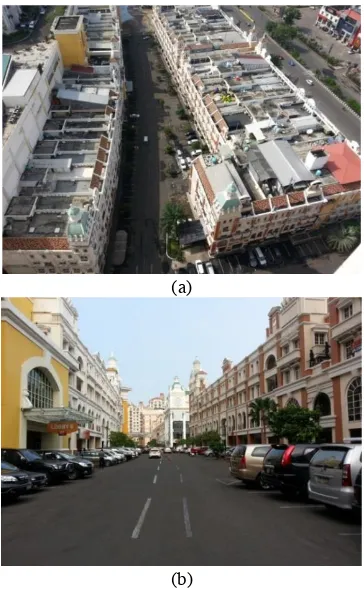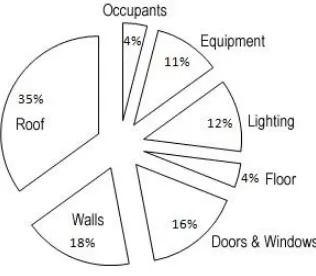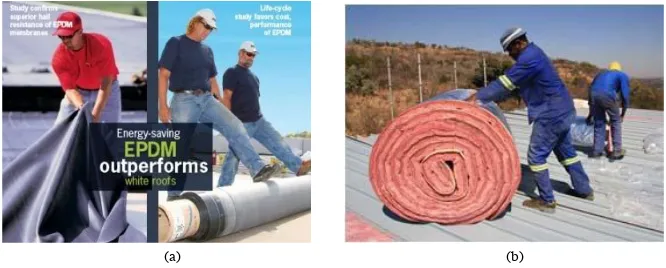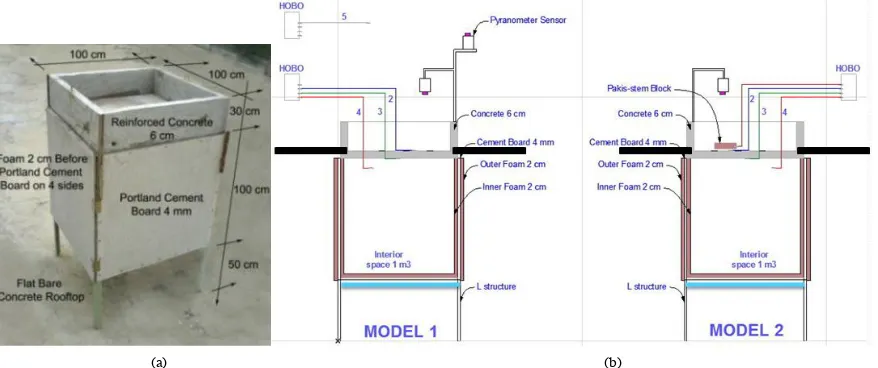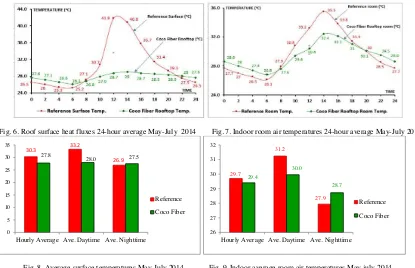Procedia Engineering 125 ( 2015 ) 765 – 772
1877-7058 © 2015 The Authors. Published by Elsevier Ltd. This is an open access article under the CC BY-NC-ND license (http://creativecommons.org/licenses/by-nc-nd/4.0/).
Peer-review under responsibility of organizing committee of The 5th International Conference of Euro Asia Civil Engineering Forum (EACEF-5) doi: 10.1016/j.proeng.2015.11.129
ScienceDirect
The 5th International Conference of Euro Asia Civil Engineering Forum (EACEF-5)
Application of coconut fibres as outer eco-insulation to control
solar heat radiation on horizontal concrete slab rooftop
Danny Santoso Mintorogo
a,*, Wanda K Widigdo
a, Anik Juniwati
aaDepartment of Architecture, Petra Christian University, Jalan Siwalankerto 121-131, Surabaya 60235, East-Java, Indonesia
Abstract
Many countries alongside equator will experience excessive solar radiation, regardless the top and four sides of the buildings’ surfaces. Due to the modern architectural concept and fast growing industry and economic, hundreds of rows of two-to-three-story shops and office houses have been built on the central business districts. Those buildings built are equipped with flat bare and uninsulated concrete rooftop. Only few of flat rooftops are equipped with numerous un-eco-insulation developed in the world such as asphalt roll membranes, single-ply rubber membranes, Ethylene Propylene Diene Monomer (EPDM), and Thermoplastic Polyolefin. This paper deals with the use of coconut fibres to build thermal insulation on concrete slab roofings and the experimental measurements of roof surface and indoor air temperatures derived from dynamic climatology of solar radiation. Monthly average temperatures on rooftop concrete slab and room air temperatures were conducted. Coconut fibres will be considered as natural sustainable insulator with the following aspects: practicing to respect natural materials within the built environment, promoting less harzardus roofing insulation of the material used, limiting the impacts on the urban-built atmosphere, and preserving cooling energy demand by mitigating the flat concrete rooftop thermal onto the room. The room air thermal saving covered by coconut fibres is around 2.8o– 3.1oC different, and the rooftop surface thermal saving with coconut fibres is 13oC different, compared to conventional bare concrete slab roofings. The energy consumption reduction is around 3% (average) and 9% (maximum).
© 2015 The Authors. Published by Elsevier Ltd.
Peer-review under responsibility of organizing committee of The 5th International Conference of Euro Asia Civil Engineering Forum (EACEF-5).
Keywords:Coconut fibres; eco-friendly insulation; solar radiation; concrete flat slab roofing.
* Corresponding author. E-mail address: dannysm@petra.ac.id
© 2015 The Authors. Published by Elsevier Ltd. This is an open access article under the CC BY-NC-ND license (http://creativecommons.org/licenses/by-nc-nd/4.0/).
1.Introduction
Over the past decade, the economy in Asia-Pasific has been growing fast; Indonesia with Jakarta as capital city also acquired lots of places for dealing with the economic-growth demand such as low, middle and high-rise office buildings. One of the favorite types for dealing business places is Ruko or Rukan; it is a kind of landed houses with one to three story-building called shop-house or office-house. Most of these shop-office houses finish the rooftop with flat bare concrete, and these flat concrete rooftops mostly are not covered with outer insulation in order to perform as a heat barrier to solar radiation during the day. Other cities also have the same system for those shop-office houses in the central business districts (see Fig. 1a and Fig. 1b). Surabaya is the second largest city after Jakarta in Indonesia. Surabaya, situated at lattitude 7o 17-21’ South and longitude 112o47’ East, has a tropical warm
humid climate zone throughout the year. It has two seasons; the dry season from May to November and the rainy season from December to May. Based on three local weather stations climatic data from 1993 to 2005: J (airport zone—Southern areas), P1 (center city—center areas), P2 (harbor zone—Northern areas), the maximum average dry-bulb outdoor temperatures stretches from 33o to 35oC, and the minimum average web-bulb outdoor temperatures
ranges from 22o to 24oC (Table 1) [1].
Plenty of horizontal exposed concrete rooftops on every shop-office houses, which mostly have been equipped with air conditioning system will cause extra millions of Watt-hour of cooling load penetrated from the rooftop into the rooms due to the high intensity of solar radiation in Surabaya. There are several facts of horizontal concrete roofs of shop and office houses in Surabaya, such as: 1) uncovered rooftop surfaces, 2) high intensity of horizontal solar irradiance.
(a)
(b)
Table 1. Maximum and minimum average outdoor temperatures 1993-2005
1993 1995 1996 1997 1998 1999 2001 2002 2003 2004 2005 Month Max Min Max Min Max Min Max Min Max Min Max Min Max Min Max Min Max Min Max Min Max Min
1 33.2 23.3 34.3 23.1 33.2 23.5 33.3 23.2 36.1 23.8 33.0 23.2 34 4 23.2 34.2 21.7 35.2 22.7 34.3 22 9 33.3 24.6 2 33.5 23.2 33.6 23.0 32.9 23.3 34.0 24.3 34.7 23.3 33.3 23.5 34 4 23.4 33.6 23.3 33.9 22 9 33.9 23.2 33.2 23.9 3 32.7 23.9 33.6 22.4 33.7 23.5 34.4 23.1 35.2 23.9 33.4 23.3 34.3 22.9 34.6 23.1 34.7 22.2 34.7 23.2 33.3 24.3 4 32.9 24.0 34.3 22.6 33.9 23.7 33.6 23.6 35.2 24.4 33.3 23.9 34.3 23.4 34.8 23.4 34.9 23.9 34.8 23.8 32.6 24.3 5 33.2 24.3 33.9 22.7 33.6 22.4 33.7 23.5 34.4 24.2 32.9 23.4 34.3 22.0 34.0 23.3 34.2 22.6 34.2 22 5 32.6 24.6 6 32.8 23.6 33.8 23.0 32.8 23.7 32.7 21.2 33.7 24.1 33.2 23.6 33.2 22.2 33.8 21.5 33.6 21.0 33.7 21.5 32.5 24.5 7 32.7 21.3 33.1 21.1 33.0 22.2 32.9 20.0 33.4 23.5 32.0 22.1 32.8 19.7 33.7 20.9 33.5 20.2 33.6 21.3 32.0 22.9 8 32.3 22.2 33.0 20.8 33.3 22.1 32.0 20.0 34.1 23.0 33.0 21.2 33.1 20.6 33.2 20.0 34.0 19.8 33.4 20.3 32.4 22.7 9 33.6 22.5 34.9 21.6 34.7 22.9 34.3 21.1 34.7 22.0 33.8 20.8 35.2 22.9 34.1 21.5 35.6 20.1 34.5 21.5 33.6 24.2 10 35.3 23.5 35.6 22.6 35.3 23.9 36.4 20.1 34.6 23.9 34.7 22.7 35.4 23. 5 36.9 21.9 36.3 22 9 36.7 22.3 34.4 24.0 11 35.3 24.2 35.4 22.9 34.9 23.5 36.3 22.9 34.5 24.0 33.8 23.7 35.3 23.5 36.8 23.3 37.0 22.5 37 0 23.1 34.5 23.8 12 34.5 23.8 34.0 22.8 34.1 23.7 36.0 23.6 34.8 23.7 33.8 23.7 34 2 23.1 35.9 23.3 34.7 22.9 35.3 23.0 32 7 23.9 Ave 33.5 23.3 34.1 22.4 33.8 23.2 34.1 22.2 34.6 23.7 33.4 22.9 34.2 22.5 34.6 22.3 34.8 22.0 34.7 22.4 33.1 24.0 Source : Surabaya Weather Station, (1993-2005)
1.1.Surface exposed
Low-rise building of shop-houses are built in rows, and it is only the front facade that is exposed to the weather, and is impacted by the solar irradiation. The rooftop portion of the shop-houses definitely suffer from lots of solar irradiation. Fig. 2 indicates that rooftops are the biggest portions of the building that transmit thermal solar
irradiation into the building, which is around 35%. The total front facade elements (walls, doors, and windows) only contribute around 34% of the thermal loads to room. Meanwhile, the integrated interior components
(occupants,equipment, lighting, and floor) contribute roughly 31% of the thermal (Fig. 2).
Fig. 2.Thermal transmitted resources to building percentage (image source: Tippins, 2009)
1.2.High intensity of solar irradiance
Because Surabaya is located at lattitude 7o17’- 21’. It is near to the equator and has the typical warm and humid
tropical zone weather. That is why the solar radiation intensity is higher than the locations in subtropical zone. Tropical regions have two seasons, which are dry and rain season. During the dry seasons, the average horizontal global solar irradiance in 2008 was 397 W/m2. At the present time, the solar irradiance is only 302 W/m2 in rainy
seasons (Table 2). Assuming that one unit rooftop shop-house has around 100 m2 (5x20 m), the thermal irradiance
Table 2. Daily average horizontal global solar radiation per month per year (W/m2)
Dry seasons 2007 2008 2009 Rainy seasons 2007 2008 2009 May 335 369 292 January 349 327 306 June 316 360 337 Pebruary 335 255 268 July 252 382 357 March 280 297 339 August 408 414 384 April 363 357 337 September 443 415 409 November 408 304 344 October 446 440 424 December 306 271 321 Average 383 397 367 Average 340 302 319
Source:author
1.3.Non Eco-friendly roof insulated material
There are lots of insulation used for rooftops, either for the outer or inner side of the flat and till roofs. However, most of them are still chemical-base. Modern countries are used to apply roofing membranes with thermoplastic polymer-basedas insulation materials such as PVC, TPO (thermoplastic polyolefin). Others built up roofing membranes applied to horizontal rooftop, like Ethylene Propylene Diene Monomer-based coating (white roll membranes) (Fig. 3a), and elastomeric-based coatings (single-ply rubber membranes). More up to date roll insulation material is 10 mm thick of glasswool (packed with aluminium foil on both sides (Fig. 3b). Among those chemical-based insulation materials, PVC is the most expensive and durable, with long-term performance [2].
(a) (b)
Fig. 3. (a) Roll of white EPDM membrane; (b) Roll of glasswool-aluminium foils outer roof insulation
2.Related literatures
The efforts to control solar heat radiation on horizontal roofs are different, depending on the era. They vary from earth shelters (ancient era), chemical insulations (industrial era), and cool roofs, green roofs, and roof ponds (modern era), as well as eco-friendly insulations (sustainable eco-friendly built environment era).
Horizontal roofs are evolving in physical forms and functions in accordance with the attempts of controlling the heat solar radiation and providing solutions for the humidity problem (weather) [3].
Cool roofs, green roofs, and roof ponds are perfect to be considered as sustainable roofing systems to control the heat gain on flat concrete rooftop. Applying cool roof relies on the high percentages of roof color’s reflectance. It gains greater benefits in the daytime energy performances by lessening cooling energy loads. Meanwhile, green roofs have more steady surface temperatures than cool roofs because of the layers of substrate, and the growing thickness of the medium [4]. Generally, a cool roof is formed by simply applying a highly reflective roof material and light color over an existing rooftop but not always, since darker colors are the new invention of cool colors’ roofing materials [5]. Customarily, a cool roof is appropriate for a warm and humid climate. It will not experience a
color materials, which reflect 95% of solar radiation onto the range of visible light and near-infrared heat [6]. Oftenly, the white cool roof can reflect 75% and emit 92% of total sun heat energy into space, leaving the rooftop surface dry-bulb temperature on 49oC. Conventional flat concrete rooftops can reach to about 60o to 70oC [7].
Meanwhile, the surface dry-bulb temperature of a built-up asphalt roof, white PVC-covered roof membrane, and green roof can reach up to 70oC, 38oC, and 32oC respectively, during the typical summer hot day [8]. Green roofs
speciality performance tested by Puay Yok Tan and Angelia Sia [9]. They reported at Rooftops for Sustainable Communities conference that the green roof test of multi-story car park projected 5 – 10 cm of growing soil layer to 25 cm of bare exposed flat concrete rooftops. The 25 cm concrete roof covered with a green roof leads to 15o - 20oC
cooler surface temperature on the concrete green rooftop than on the bare adjacent concrete surface.
A roof pond is a passive cooling roof, considered to have greater cooling and heating energy savings within 24-hour cycles of particular climatic seasons —summer and winter. Numerous measurements on roof pond roofing passive cooling techniques, like wind driven roof pond, fastening cooling water pond, and water-pipes based roof pond, are proved to lessen the heat on flat concrete rooftop. The water-pipe based roof pond system experiences 1.4oC cooler dry-bulb room temperature than a regular roof pond, and 4.4oC cooler than a conventional surface
concrete rooftop temperature [10]. Meanwhile, the wind pipes system experiences 0.4oC cooler room temperature
than a regular roof pond, and 3.4oC cooler surface temperature than a conventional concrete rooftop [11].
Coconut fibres could be used in the construction field of civil engineering as a reinforcement composite concrete with portland cement, fine agg, coarse agg and water. The adding of the coconut fibres in composite concrete significantly enhances the properties of the concrete in terms of its tensile strength, torsion, and hardiness. However, the segment percentages of coconut fibres in the composite concrete undesirably affect the concrete compressive strength [12, 13 & 14]. Another function of coconut fibres is to overlay the top of concrete slab. It can discharge solar radiation thermal in order to improve the indoor thermal. Rodriguez et al. [15] applyed FEM analysis on coconut fibre to find its thermal conductivity and layering possition on concrete slab, like on the top or inner concrete slab. The coconut thermal conductivity of k is 0.048 W/m.K, with density of 174 kg/m3, and heat capacity
of 2600 J/KgK. Coconut fibres on the top of concrete slab are better as a thermal insulator than on the inner of the concrete slab [15].
3.Methodology
The research is a quantitative experimental work measured in situ at Petra Christian University two-story building rooftop, with two-model experiment, and coconut fibres as an eco-insulation to flat concrete rooftop materials. Natural coconut fibres were obtained from the coconut, and the coconut fibres were laid down over the concrete rooftop model (Fig. 4c).
(a) (b) (c)
Fig. 4.(a) Original coconut fibres, (b) HOBO U12 with thermocouple probe, (c) Coconut fibres in the test-model (Source: author).
The measurements were calculated with two models simultaneously from May to July 2014, one model acted as the reference model (original flat concrete rooftop), and another rooftop model was covered with 5-cm coco fibres (one layer only) as a starting point. Other possibilities of layerings test (10 cm, 15cm, 20cm and so on) will be done in the incoming research (Fig. 4c). The measurement was done in dry mode only. The HOBO data loggers were adjusted to record all temperatures for every 10 minutes and went on for three months (May to July 2014). The research was scheduled to start in May due to the time constructing of the models and ended to July. Subsequently, the data from data loggers were interpreted in monthly average in order to complete the graphs in Microsoft excel.
The technical data of the coco fibres are in terms of the loads in dry mode and wet mode. The dry-load of the coco fibres with a covered dimension of 1m x 1m x 0.05 m (0.05 m2) is about 1.56 kilogram. The wet coco fibres
load is around 3.05 kilograms.
(a) (b)
Fig. 5. (a) A built-up model with flat concrete rooftop, (b) Processing figures of models and tools (Source: author).
4. Results and disscusstions
All temperatures data (surface rooftop and room model) were required to accumulate an hourly average format before obtaining a 24-hour graph of rooftop surface and room thermal.
The concrete roof surface temperature on reference model reached 41.8oC at noon. The roof concrete surface
covered with coconut fibres was only 28.7oC at 12 noon. Therefore, there was a thermal surface gap on daytime
period (6 am to 6 pm), roughly 13oC, 12oC, 7oC and 3oC respectively in the afternoon (2 pm, 4 pm, and 6 pm) (Fig.
6). At nighttime (6 pm – 6 am), the reference roof surface temperature released the stored-heat at the flat concrete roof faster than the coconut fibres rooftop. The time when the rooftop and coconut fibres rooftop discharged stored-heat started around 10 pm – 6 am. The average roof surface temperature is 26.9oC, and the coconut fibres rooftop
have an average roof surface temperature of 27.5oC (Fig 8). Therefore, the coconut fibres rooftop needed a longer
time to release roof-surface-concrete radiated heat to the cool night sky radiation due to the coconut fibres covering the top of the concrete roof.
The maximum indoor room air temperature on reference model reached 35.5oC at 2 pm. On the other hand,
concrete surface covered with coconut fibres model only had maximum temperature of 32.4oC. It was 3.1oC cooler
than reference model at the hottest afternoon (2 pm) (Fig. 7). Looking at the afternoon time, the indoor room air temperature of coconut fibres rooftop model was 2.8oC different compared to room air temperature of reference
model. The average daytime dry-bulb indoor room air temperature on coconut fibres rooftop was 30oC, and the flat
bare concrete rooftop had an average dry-bulb room air temperature of 31.2oC. So, the different between daytime
and nighttime average indoor room air temperature to reference room air model was 1.2oC and 0.8oC respectively
Fig. 6. Roof surface heat fluxes 24-hour average May-July 2014 Fig. 7. Indoor room air temperatures 24-hour average May-July 2014
Fig. 8. Average surface temperatures May-July 2014 Fig. 9. Indoor average room air temperatures May-july 2014
In order to have a better understanding of outer insulation performances on flat bare concrete rooftop, there are several types of outer insulations that covered the top of the horizontal bare concrete rooftop. Table 3 shows coconut fibres covered on horizontal bare rooftop had the lowest average room air temperature among other applications. The room air temperature was 0.4oC cooler than the conventional bare concrete roof (done in another research done
at different time, location and climate). The room air temperature was also 0.4oC different compared to the
changeable media green roof test that was measured on the same location but at a different time of the year.
Table 3. Various types of thermal fluxes on rooftops and insulations
Application of rooftops Average rooftop surface
Coconut fibres rooftop 27.8 29.4 Mintorogo, 2014 Cool roof (white painted) rooftop 34 - Carnielo et al., 2011
Metal rooftop 60 -70 - Wong and Chen, 2006
Green roof - intensive style 38 - Wong and Chen, 2006 Roof pond rooftop 36.9 32.5 Mintorogo and Widigdo, 2010 Water pipes roof pond 37.3 32.3 Mintorogo and Widigdo, 2011 Wind pipes roof pond 35.2 34.6 Mintorogo and Widigdo, 2012 Pakis stem block insulated
rooftop 29.8 30.9 Mintorogo, 2014
Styrofoam insulated rooftop 31.4 31 Mintorogo, 2014
Yumen Board 34.3 32 Mintorogo, 2014
Changeable media green roof 29.3 29.8 Aditya, 2014
Eggshell rooftop 32.3 31.1 Suryadi, 2014
5. Conclusions
Looking at Fig. 6 and Fig. 7, as well as table 3, several points about coconut fibres as outer insulation on horizontal rooftop can be concluded:
1. Concrete rooftops covered with coconut fibres have lower surface heat fluxes during the daytime and are faster to release the stored heat due to the natural perforating material of coconut fibres.
2. Coconut fibres rooftops experience a lower indoor air temperature during the daytime but not at the nighttime.
3. Coconut fibre is a natural material, therefore it decomposes faster and more easily. It pertains a clean built environment.
4. Coconut fibres can be recycled as a natural material.
5. Coconut fibres can be introduced as an insulation to flat concrete rooftops besides straw and fibre reeds. 6. We practice to respect the use of more natural materials for the buildings.
Speaking for energy savings domain, the coconut fibres rooftop can reduce an average indoor air temperature up to 1.2oC, and the indoor room air temperature up to 3.1oC at 2 pm. According to Kam M.S. [16], the cutback of
electricity utilization in the air-conditioning equipment is roughly 3% for every increasing/reducing of room air temperature of 1oC (a mock-up of the energy use of a standard office building in Hong Kong with central
air-conditioning system). Therefore, the coconut fibres insulation on a flat bare concrete rooftop could save an energy consumption to around 3% (average) and 9% (maximum).
Acknowledgements
The author would like to thank to the Head of Architecture Department, Petra Christian University Surabaya for funding the research and measurement tools.
References
[1] Surabaya Weather Station, 1993-2005
[2] B. Tippins, EPDM roofing systems: a strong, energy-efficiency option, 2009.
[3] ST. Vasiliu, Evolution of flat roof, Buletinul Institutului Polithenic Din Iasi, J.Tomul. LV 4 (2009) 71-80. [4] M. Magallanes, Cool roof and photovoltaics: an unlikely pair. FMJ report, July-August (2011) 42-45.
[5] N. Garrison, C. Horowitz & C.A. Lunghino, Looking up: how green roofs and cool roofscan reduce energy use, Adress climate change and protect water resources in southern California, NRDC report, New York, 2012.
[6] S.J. Konopacki & H. Akabri, Measured energy savings and demand reduction from a reflective roof membrane on a large retail store in Austin, BLNL-47149, Berkeley, CA, 2001.
[7] N.H. Wong & Y, Chen, A comparation of two rooftop systems in the tropical climate, Proceeding of the iNTA2nd Harmony in culture and
nature, Indonesia, 2010, B14, 1-8.
[8] J. Richie, Green roof and walls, Presentation to Ontario congres, GRHC, 2012.
[9] P.Y. Tan & A. Sia, A pilot green roof research project in Singapore, Proceeding of the third annual greening rooftop for sustainable community conference, Washington DC, USA, 2005.
[10] D.S. Mintorogo & W. Widigdo, Water-pipes based roof pond reduce thermal flat concrete rooftop, Research Project at Petra Christian University, Surabaya. 2011.
[11] D.S. Mintorogo & W. Widigdo, Wind-driven roof pond fastened cooling effects of water pond in tropical climate of Surabaya, Research Project at Petra Christian University, Surabaya. 2012.
[12] P.P. Yalley & A.S.K. Kwan, Uses of coconut fibres as a enhencement of concrete, Cement and concrete composite, Indian coconut journal,
15, 54-73, 2009.
[13] A. Majid, Coconut fibre – a versatile material and its applicantions in engineering, available online: http://www.claisse.info/2010%20papers/k13.pdf.
[14] R. Sabah M., M. Ansari & M. Saleh H., A study on mechanical, thermal and morphological properties of natural fibre/epoxy composite,
Design for scientific renaissance, 1(5), 267-296, July 2012.
[15] N.J. Rodriguez et al., Assessment of coconut fibre insulation characteristics and its use to modulate temperatures in concrete slabs with the aid of a finite element methodology, Energy and buildings, 43, 1264-1272, 2011.
